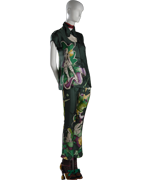When Japanese designer Issey Miyake began collaborating with textile designer Junichi Arai in the 1980s, he introduced the fashion industry to a new generation of fabrics. These included unique blends of metallic threads and synthetic textiles. At the same time, Parisian designer Marc Audibet collaborated with DuPont to combine Lycra with cotton or linen to create a "bi-stretch" material that would revolutionize high-end sportswear.
 In the late twentieth century, personal computers and the introduction of the internet transformed culture. The impact on fashion was felt when designers such as Jean Paul Gaultier turned to "cyberspace" for aesthetic inspiration, and computer aided design (CAD) programs began to alter the ways garments were produced. In 1998, Helmut Lang became the first designer to debut his collection on the internet, making the high fashion runway show available to not only the fashion industry "elite," but also a larger, more internationally and demographically diverse audience than ever before.
In the late twentieth century, personal computers and the introduction of the internet transformed culture. The impact on fashion was felt when designers such as Jean Paul Gaultier turned to "cyberspace" for aesthetic inspiration, and computer aided design (CAD) programs began to alter the ways garments were produced. In 1998, Helmut Lang became the first designer to debut his collection on the internet, making the high fashion runway show available to not only the fashion industry "elite," but also a larger, more internationally and demographically diverse audience than ever before.
Digital technology continues to transform the promotion, fabrication, and basic design of fashion. The Dutch design studio Freedom of Creation are taking advantage of developments in 3D printing to fabricate entire ensembles using a computer. At the micro level, advancements in sewable electronics (such as conductive threads and microprocessors that are integrated into fabrics) have enabled designers to create garments that can play music, answer telephone calls, and even monitor the wearer’s heartbeat.
Fashion and Technology was organized by Ariele Elia and Emma McClendon, along with Colleen Hill and Lynn Weidner.
Download a PDF of the brochure here.
The exhibition has been made possible thanks to the generosity of members of the Couture Council.
